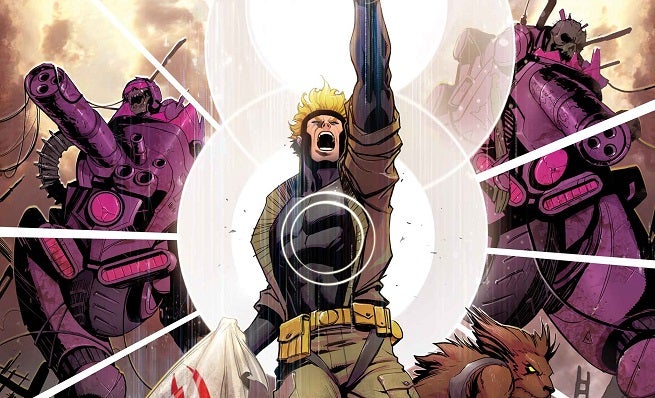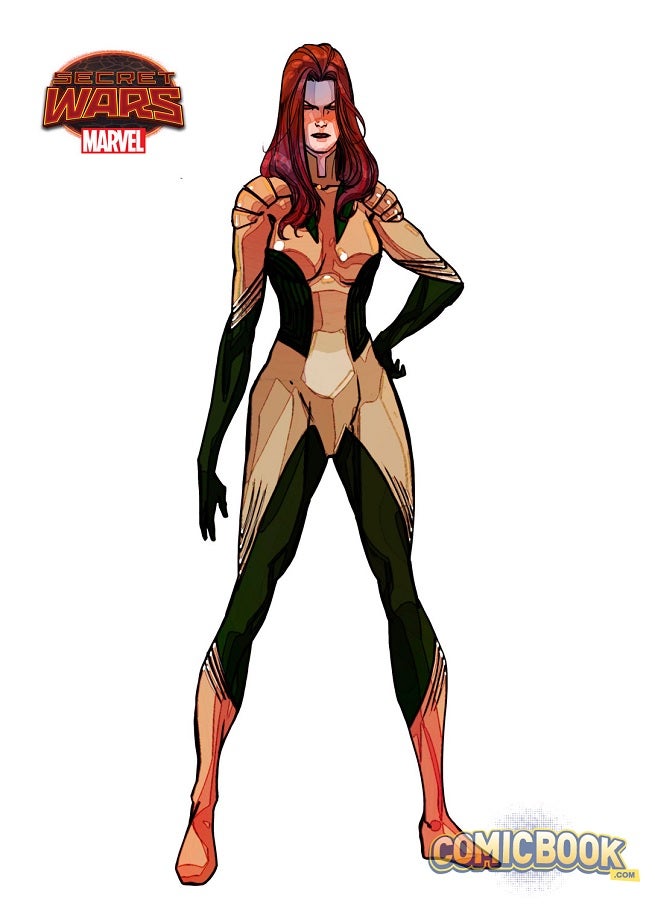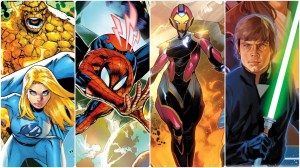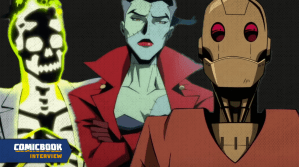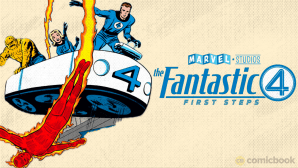Videos by ComicBook.com
The series begins in June, and will be written by X-Men and Arrow scribe Marc Guggenheim with art by Carmine Di Giandomenico.
X-Tinction Agenda will take place under the Warzones! banner in a world where the status quo of the classic ’90s X-Men event became the dominant future of the Marvel Universe, and picks up years later with Havok and Wolfsbane still running the nation of Genosha.
You can check out the official solicitation text directly below.
X-TINCTION AGENDA #1
Written by MARC GUGGENHEIM
Penciled by CARMINE DI GIANDOMENICO
Cover by DAVID NAKAYAMATen years since the fall of Cameron Hodge and his fascist regime. Ten years that Havok and Wolfsbane have labored to rebuild Genosha. But their work may be for naught, as a plague has spread across their nation, infecting mutants and threatening their race with extinction. With the country quarantined and seemingly abandoned by the rest of the world, including the X-Men, old friends may become new enemies as Genosha’s rulers fight to save their people! Experience an alternate future fueled by the events of the landmark first X-Crossover of 1990, X-Tinction Agenda!
32 PGS./Rated T+ …$3.99
Since the original series featured the work of names like Chris Claremont, Louise Simonson, Jim Lee, Rob Liefeld, Jon Bogdanove and Marc Silvestri, picking up the story from there is quite a job for any creative team. Guggenheim joined ComicBook.com to talk about the series, its challenges and why he’s so excited about Secret Wars.
I was given a lot of free reign in terms of what story to pitch. It started out with Marvel saying, “Are there any X-events that you would love to revisit?” I had this idea for essentially a sequel to X-Tinction Agenda.
There’s a couple of different ways to approach this kind of project. You can kind of retell the event with a slightly different spin, you can pick up different threads from the event. I was sort of intrigued by something that felt like a sequel but at the same time, I also wanted to take advantage of the new status quo and the new opportunities presented by Battleworld.
My X-Tinction Agenda is sort of this fun sequel that plays like a sequel on one level but plays into a different future for the X-Men than the one we’re familiar with in the comics.
It sounds almost like doing this as a film sequel as opposed to the next episode of TV.
Yeah, a little bit. I think what’s really fun about the whole Secret Wars concept is that in a very organic and not forced way, it allows all the writers and artists and all the readers to explore these concepts and look at them from different angles and in different ways. Secret Wars really feels like a love letter to the Marvel Universe and really a love letter to the history of Marvel Comics up to this point.
You know, it’s funny. I’ve heard that exact thing about Convergence.
That’s hysterical. And by the way, I’m not surprised. The original Secret Wars and Crisis on Infinite Earths has a fairly large overlap in terms of time between those two twelve-issue series. There’s always been a certain zeitgeist-y parallel. So there’s definitely parallels between Secret Wars and Convergence and I think it’s an exciting time to be a comic book reader.
I hadn’t read X-Tinction Agenda in years until I bought the trade to brush up for this conversation. I’d forgotten how Havok-centric it is. It sometimes seems like writers struggle with writing him beyond just being Cyclops’ insecure brother, but you have him set up as essentially ruler of a country. Was it fun to get to push that character to a new level?
Yeah. One of the things that I’m doing with my story is that I’m picking up from the way X-Tinction Agenda ended, which is Rahne — Wolfsbane — and Havok staying behind to rebuild Genosha.
So when we pick up with them, it’s several years later and Havok’s definitely his own man, he’s not living under his brother’s shadow. He’s got a whole host of problems that are unique to him and unique to Genosha. It’s kind of nice; I’ve always thought Havok was a really, really cool character and writing him is a real pleasure; I’ve never got a chance to write Havok before.
You know, for me I hear Rahne’s voice in my head very loudly because I grew up with the New Mutants run and that’s sort of the Rahne I’m going back to.
The hardest part for me is getting the accent right.
There are a lot of accents in that era of the X-Men.
Yeah, it’s tricky, but I find like the Scottish is particularly hard. In print, some of the Scottish feels like a casual slang and Rahne is not a casual person. She’s brought up in this very proper, cloistered way and she speaks with a certain politeness and a certain deference.
I’m trying to show that all these years of basically co-running Genosha with Havok have taken their toll on her so she’s a little more rough around the edges than she used to be…but at the same time, it’s finding that right balance where she’s rougher around the edges because she’s lived this life we haven’t seen off-camera but at the same time she’s still Rahne and you want her to be the character that she’s always been.
So those two are your topliners, but who else plays a role in this miniseries?
X-Tinction Agenda X-Tinction AgendaWe’ve got Wicked, who is a pretty obscure character from Claremont’s Excalibur Volume III run, which is set in Genosha. I wanted a character who was already set in Genosha, and I think she has a cool power, too, which is she can conjure ghosts.
We have a new character called Bulletproof who, as his name might imply, is impervious to projectiles and whatnot, but he’s got a role to play in the book that is I hope going to be very surprising to people. My hope for him is that he’ll end the series as sort of the breakout character.
One of the things I always try to do whenever I do work for DC and Marvel — it’s sort of the approach that I took to my X-Men run that wrapped up a couple of months ago — which is I like to pull up stuff from the past but at the same time, put new toys in the toybox as well. It’s a little bit like a give a penny, take a penny approach to writing these characters. So Bulletproof is my new contribution.
[Editor’s Note: You can see our interview with Guggenheim about that X-Men run here.]
That’s sort of on the Genoshan side of things. Mystique and Karma are also part of the new Press Gang, the group of super-powered mutants who are responsible for maintaining law and order in Genosha. But then on the X-Men side, we’ve got Phoenix, we’ve got Wolverine from circa Giant-Size X-Men #1 because in this version of reality, Hank McCoy brought old X-Men from the past into the present, but he chose the ones from Giant-Size X-Men #1 instead of the X-Men from the 1960s.
So a lot of fun. My hope is as I work through the book is to just pop in a little bit and see cameos from a lot of characters. I’m going to bring back Ink from my Young X-Men run because I’m massively fond of him.
…And he’s a movie star, now.
And he’s a movie star now! That was a big bucket list item for me to check off, I’ll be honest.
Triage from Brian Michael Bendis’ X-Men run has a very significant role to play. But when you think of it, the conceit of the X-Tinction Agenda has a group of Genoshans to go to Westchester, kidnap a bunch of X-Men, bring them to Genosha, some remaining X-Men need to go to Genosha to free them and chaos ensues.
If you consider that the shape of the original X-Tinction Agenda, as with any sequel I wanted to replicate that shape but with some twists and turns and unexpected developments that make it unique and not make it a carbon copy of X-Tinction Agenda.
To what extent are you guys meant to tie into Secret Wars, versus how much is just doing your own thing and the concept is what ties it in?
I think it depends on the miniseries.
How I’ve been approaching it is, the beauty part of what Marvel’s doing is that there is no more Marvel Universe, there is just Battleworld, and Secret Wars is sort of your tour guide to that world.
So I’m kind of writing this the way I would write any Marvel Universe book. It just so happens that this Marvel Universe that I’m playing with is within the context of this larger Battleworld and Secret Wars narrative. I really give Marvel a lot of credit: Secret Wars doesn’t follow the rules of a traditional crossover. I know there’s a spine book and there are tie-ins but because there are no non-Secret Wars books and there’s no Marvel Universe, it feels like its own thing that’s never been done before.
I feel like that’s really appropriate, because the original Secret Wars had never been done before — so all the old rules are thrown out the window and you really feel like all of these books are trying something brand new, which I really think is wonderful. It’s a great opportunity to really shake things up.
Of course, after the original Secret Wars, the event cycle ramped up and never really stopped. Do you think doing this, we’ll see the whole publishing lines just ending every summer now?
[Laughs] I don’t think so. I think both Marvel and DC recognize that continuity has a big role to play and Secret Wars is going ot have a long-lasting impact on Marvel continuity. I know a lot of people think it’s about throwing out continuity and the beauty part of it is, it’s not.
It’s going to require a few months of faith on the part of comic book fans, which I know doesn’t come easy for one month, but what Marvel’s doing is really, really, really cool.
Whenever we do this sort of thing, you have to approach it from the standpoint of, your first job is to tell a good story. That’s got to be mission number one. It’s not about tie-ins, continuity…everything else has to be secondary to telling a good story. I don’t think anyone’s ever read a badly-written story or a badly-executed story and went, “Well, that really sucked but oh geez, it really was faithful to continuity.” It has to start with the story and it has to start with the characters.”
The artists on the original X-Tinction Agenda were a murderer’s row of big-name talent at the time. How did you decide on Carmine Di Giandomenico?
The trickiest thing is that the 1990s books like X-Tinction Agenda have a very distinctive look, and it’s a distinctive look that doesn’t age well and that a lot of artists that are working today can’t quite replicate. So we sort of made the decision early on that we were going to try and honor the roots of extinction agenda in other ways.
Carmine just has this really great style and I wouldn’t say it feels 1990s but it feels unique and it has a point-of-view to it.
I think there’s a sense of movement and energy that feels very kinetic to me, and whether you like the look of the ’90s or not, that’s something you can say about those books. There was just pent-up energy everywhere.
Absolutely. And there was a different pace in terms of panels per page and everything. Carmine has a wonderful sense of storytelling and his designs are terrific.
Again, part of the fun of the book is that you’re seeing a version of the X-Men and I sort of had a sense that this is what I wanted people to look like and places to look like, and Carmine really nailed them. His design work on the book, which is not an insignificant part of this particular story because of the nature of it, he’s done a really great job.


